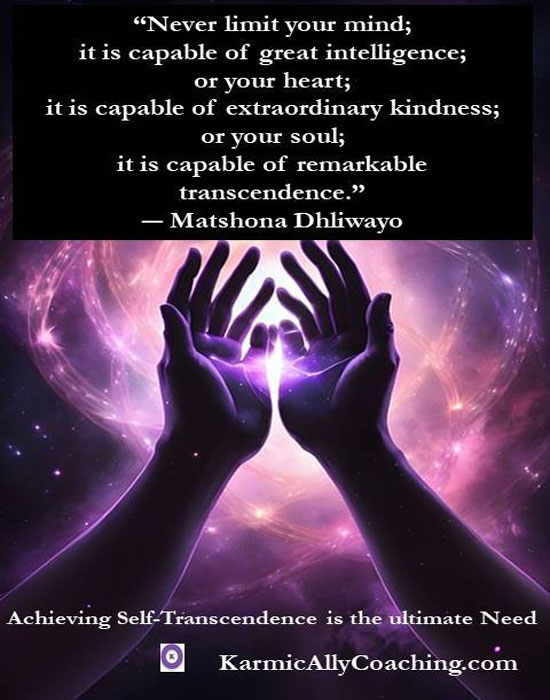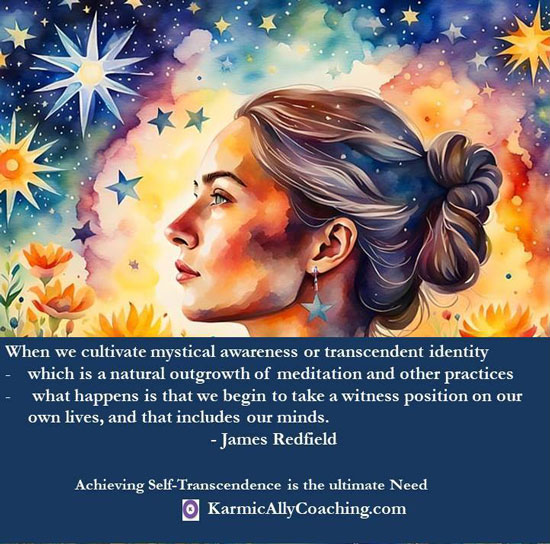This post has already been read 306 times!

Ever wondered why professionals whose careers are going great guns suddenly decide to change track and do something completely different?
Quite often it’s a desire to achieve something on their own to satisfy their desire for self-actualization.
But what if that desire is more than just self-actualization?
What if they want to serve a bigger cause?
Is there something that is keeping them restless at night that needs to be expressed?
There are numerous NGOs that have been set up by civil servants or corporate professionals. They left the security of a job or a 6-figure paycheck to focus on sections of society that need to be served and helped.
They’ve felt the need for a self-driven purpose and more than possible, experienced the need for Self-transcendence.
This led to a Wakeup Call and their embarking on their Hero Journey to create a new world for them.
This is not to be confused with spirituality although transcendence is a concept we learn about in spiritual teachings.
It is the quest to reach the level of personal development beyond self-actualization.
We all know about Abraham Maslow’s famous hierarchy of needs depicted as a triangle with self-actualization at the very top.
I’ve discussed this hierarchy in Do your Goals Really meet your Needs? Motivation matters.
Did you know that Maslow didn’t believe this was the real pinnacle of human development?
Maslow had realized the hierarchy was incomplete.
Self-actualization wasn’t the pinnacle of his pyramid — Self-Transcendence is.
Shortly after realizing the concept of self-transcendence as the new pinnacle but before he could develop it, Maslow became ill and passed away.
If you were to look at the existing hierarchy of needs, you’ll notice what Maslow and others noticed about Self-Actualization.
It is directed entirely on the individual and their ability to achieve their true potential. However, it excludes a concern for others.
A self-actualized person under this definition might care for others, but it is by way of satisfying their own need to be an individual that cares for others.
For example, as Maslow wrote, self-actualization could take the form of the desire to be an ideal mother.
The “ideal mother” may have a genuine concern for their child, but they are not self-actualized because of that concern; they’re self-actualized because they were motivated to become as talented a mother as they could be.

Here’s where things get interesting.
It’s not as if Maslow had missed self-transcendence, he’d simply bundled its characteristics with those of self-actualized people!
According to Maslow, self-transcendence brings the individual what he termed “peak experiences” in which they transcend their own personal concerns and see from a higher perspective. These experiences often bring strong positive emotions like joy, peace, and a well-developed sense of awareness.
Someone who is highly self-transcendent may also experience “plateau experiences”. In this, they consistently maintain or enter a state of serenity and higher perspective.
In simple words, we may feel a strong need to achieve and become all that we can be.
Once this need is met, some of us continue to feel a need that goes beyond ourselves. We start pursuing a goal that might have little to do with our self.
Self-transcendence happens when we realize that we are a small part of a greater whole and start to act accordingly.
It doesn’t matter what this greater whole or thing is, just that it is greater than the self. Some may see this as a Higher Power or cosmic power. This is part of the individual perception.
4 defining characteristics of Self-Transcendence
Self-transcendence isn’t limited to personal growth; it extends to positively impacting others and the world around us.
How will you know you’re reaching that level?
Here are four defining characteristics of self-transcendence as identified by Dr Paul Wong.
- You focus shifts from the self to others – this shift from selfishness and egoism to consideration of the needs of others is a marker of self-transcendence. It is the most salient and important feature.
- A shift in motivation and values – those who have achieved self-transcendence no longer find themselves driven by extrinsic motivation, or external rewards and demands, but by intrinsic motivation. Here, the reward for an activity is the activity itself.
- An increase in moral concern – self-transcendence brings with it a more intensive focus on doing what is right.
- Emotions of elevation – these experiences of higher-order emotions can be triggered by all 3 of the characteristics described above. The emotions include awe, ecstasy, amazement, feeling uplifted, feeling elevated, etc.
When we think about self-transcendence, we must consider the theory by nurse and researcher Pamela Reeds.
Pamela Reed’s Self Transcendence Theory
Reed defines self-transcendence as the expansion of self-conceptual boundaries multi-dimensionally:
- Inwardly (e.g., through introspective experiences),
- Outwardly (e.g., by reaching out to others), and
- Temporally (whereby past and future are integrated into the present).
She later added another type of expansion: transpersonal expansion. Here, the individual connects “with dimensions beyond the typically discernible world.”
According to Pamela Reed’s theory, self-transcendence is a natural and desired developmental stage. People must reach it in order to be fulfilled and to have a sense of purpose.
Viktor Frankl’s Resilience and purpose:
In his book Man’s Search for Meaning, Viktor Frankl, believed that man’s deepest desire is to search for meaning and purpose.
As a Holocaust survivor, he found a higher purpose even amidst immense suffering in concentration camps during World War II.
His ability to maintain hope, find meaning, and helping others despite personal hardships exemplifies self-transcendence.
Of course, one does not need to undergo prolonged suffering to reach self-transcendence. According to Maslow, it can be reached by anyone.
We may not realize it at first, but there are numerous other examples of self-transcendence all around us.

Self-transcendence in the corporate world
In the corporate world, individuals who exhibit self-transcendence often go beyond personal interests and contribute to a higher purpose.
Here are some examples:
- Philanthropic Business Leaders: Visionary business leaders like Michael Dell, Bill Gates and Warren Buffett have pledged significant portions of their fortunes to philanthropic causes. Their focus on creating positive impact beyond their own success demonstrates self-transcendence.
- Corporate Social Responsibility (CSR): Companies that engage in CSR activities, such as supporting local communities, environmental conservation, or social justice initiatives, exhibit self-transcendence.
- Employee Engagement: Organizations that prioritize employee well-being, growth, and purpose foster self-transcendence. When employees feel connected to a larger mission, they go beyond individual tasks and contribute to collective success.
- Collaborative Innovation: Teams that collaborate across departments or organizations to solve complex problems demonstrate self-transcendence. By transcending silos, they achieve outcomes that benefit the entire ecosystem.
- Sustainable Practices: Companies that prioritize sustainability and environmental stewardship act beyond profit motives. Their commitment to the planet and future generations reflects self-transcendence. For example, first movers in the international business community, like Unilever, IKEA and Patagonia, have embedded sustainability throughout their business models.
How your self-transcendent leadership style to create a high performing team.
Now that you’re aware of this pinnacle, you too can use it at as a leader to create a thriving team.
First understand your own leadership style. How do you lead? Do you mentor and guide your team as required to meet organizational goals?
Second understand your team members and how they operate. What are the team dynamics? Are there any blind spots that need to be addressed?
Thirdly, how can you plan the teamwork in a manner that satisfies their goals and acts as a motivator to achieve the bigger corporate goals? What do you need to do to achieve consensus within the team to create a strategic plan and actions that go beyond profitability?






 I adhere to the Certified Coaches Alliance Code of Ethics and Standards. A copy is available on request.
I adhere to the Certified Coaches Alliance Code of Ethics and Standards. A copy is available on request.
 Let's Talk through the Connect Form:
Let's Talk through the Connect Form: